Bird R.B., Stewart W.E., Lightfoot E.N. Transport Phenomena
Подождите немного. Документ загружается.

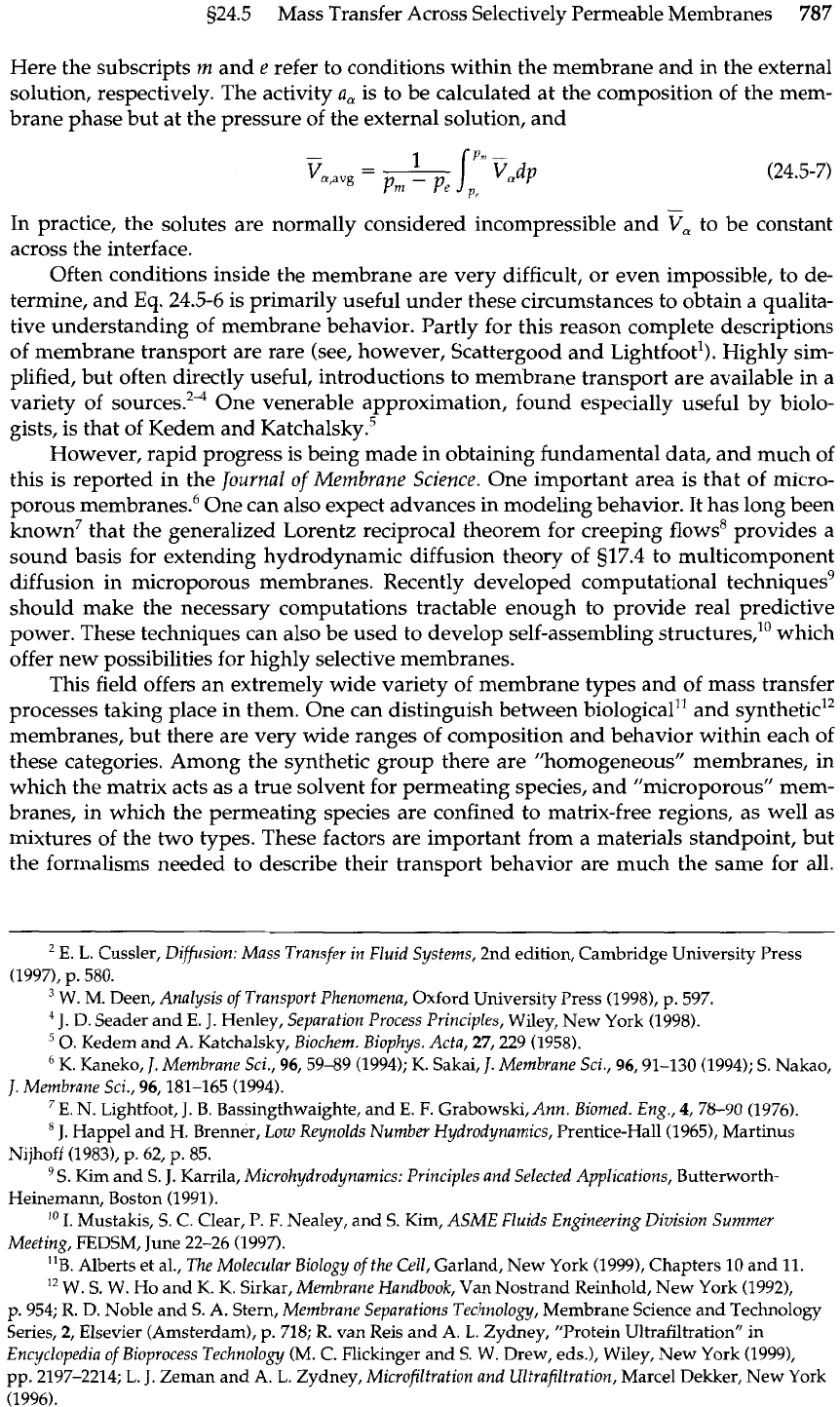
524.5
Mass Transfer Across Selectively Permeable Membranes
787
Here the subscripts
rn
and
e
refer to conditions within the membrane and in the external
solution, respectively. The activity
a,
is to be calculated at the composition of the mem-
brane phase but at the pressure of the external solution, and
In practice, the solutes are normally considered incompressible and
v,
to be constant
across the interface.
Often conditions inside the membrane are very difficult, or even impossible, to de-
termine, and Eq.
24.5-6
is primarily useful under these circumstances to obtain a qualita-
tive understanding of membrane behavior. Partly for this reason complete descriptions
of membrane transport are rare (see, however, Scattergood and Lightfoot'). Highly sim-
plified, but often directly useful, introductions to membrane transport are available in a
variety of One venerable approximation, found especially useful by biolo-
gists, is that of Kedem and Katchalsky."
However, rapid progress is being made in obtaining fundamental data, and much of
this is reported in the
Journal of Membrane
Science.
One important area is that of micro-
porous
membrane^.^
One can also expect advances in modeling behavior. It has long been
known7 that the generalized Lorentz reciprocal theorem for creeping flows8 provides a
sound basis for extending hydrodynamic diffusion theory of
517.4
to multicomponent
diffusion in microporous membranes. Recently developed computational techniques9
should make the necessary computations tractable enough to provide real predictive
power. These techniques can also be used to develop self-assembling str~ctures,'~ which
offer new possibilities for highly selective membranes.
This field offers an extremely wide variety of membrane types and of mass transfer
processes taking place in them. One can distinguish between biological" and synthetic12
membranes, but there are very wide ranges of composition and behavior within each of
these categories. Among the synthetic group there are "homogeneous" membranes, in
which the matrix acts as a true solvent for permeating species, and "microporous" mem-
branes, in which the permeating species are confined to matrix-free regions, as well as
mixtures of the two types. These factors are important from a materials standpoint, but
the formalisms needed to describe their transport behavior are much the same for all.
E.
L.
Cussler,
Diffusion: Mass Transfer in Fluid Systems,
2nd edition, Cambridge University Press
(1997),
p.
580.
W.
M.
Deen,
Analysis of Transport Phenomena,
Oxford University Press (1998), p. 597.
J.
D.
Seader and
E.
J.
Henley,
Separation Process Principles,
Wiley, New York (1998).
0.
Kedem and
A.
Katchalsky,
Biochem. Biophys. Acta,
27,229 (1958).
K. Kaneko,
J.
Membrane Sci.,
96,5949 (1994); K. Sakai,
J.
Membrane Sci.,
96,91-130 (1994); S. Nakao,
J.
Membrane Sci.,
96,181-165 (1994).
E.
N. Lightfoot,
J.
B.
Bassingthwaighte, and
E.
F. Grabowski,
Ann. Biomed. Eng.,
4,78-90 (1976).
J. Happel and
H.
Brenner,
Low Reynolds Number Hydrodynamics,
Prentice-Hall(1965), Martinus
Nijhoff (1983),
p.
62,
p.
85.
S.
Kim
and
S.
J.
Karrila,
Microhydrodynamics: Principles and Selected Applications,
Butterworth-
Heinemann, Boston (1991).
lo
I.
Mustakis,
S.
C. Clear, P. F. Nealey, and
S.
Kim,
ASME Fluids Engineering Division Summer
Meeting,
FEDSM, June 22-26 (1997).
"B.
Alberts et al.,
The
Molecular Biology of the Cell,
Garland, New York (19991, Chapters 10 and 11.
l2
W.
S. W.
Ho
and
K.
K. Sirkar,
Membrane Handbook,
Van Nostrand Reinhold, New York (19921,
p. 954; R.
D.
Noble and S.
A.
Stern,
Membrane Separations Technology,
Membrane Science and Technology
Series,
2,
Elsevier (Amsterdam),
p.
718;
R.
van Reis and
A.
L.
Zydney, "Protein Ultrafiltration" in
Encyclopedia of Bioprocess Technology
(M.
C. Flickinger and
S.
W. Drew, eds.), Wiley, New York (1999),
pp.
2197-2214;
L.
J.
Zeman and
A.
L.
Zydney,
Microfiltration and Ultrafiltration,
Marcel Dekker, New York
(1996).
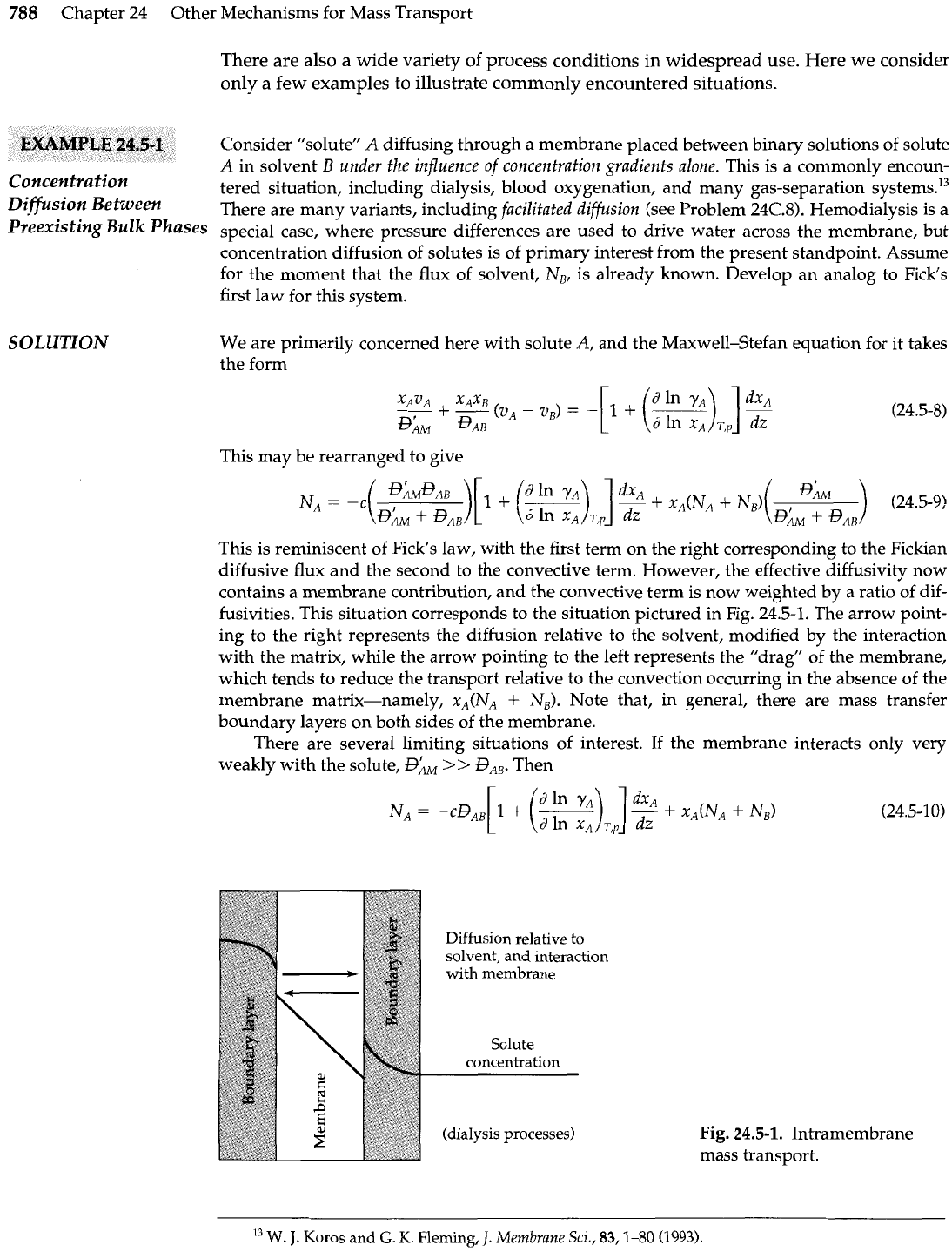
788
Chapter 24 Other Mechanisms for Mass Transport
There are also a wide variety of process conditions in widespread use. Here we consider
only a few examples to illustrate commonly encountered situations.
EXAMPLE
24.5-1
Concentration
Diffusion Between
Preexisting
Bulk
Phases
Consider "solute"
A
diffusing through a membrane placed between binary solutions of solute
A in solvent
B
under the influence of concentration gradients alone.
This is a commonly encoun-
tered situation, including dialysis, blood oxygenation, and many gas-separation systems.I3
There are many variants, including
facilitated difision
(see Problem 24C.8). Hemodialysis is a
special case, where pressure differences are used to drive water across the membrane, but
concentration diffusion of solutes is of primary interest from the present standpoint. Assume
for the moment that the flux of solvent, NB, is already known. Develop an analog to Fick's
first law for this system.
SOLUTION
We are primarily concerned here with solute A, and the Maxwell-Stefan equation for it takes
the form
This may be rearranged to give
This is reminiscent of Fick's law, with the first term on the right corresponding to the Fickian
diffusive flux and the second to the convective term. However, the effective diffusivity now
contains a membrane contribution, and the convective term is now weighted by
a
ratio of dif-
fusivities. This situation corresponds to the situation pictured in Fig. 24.5-1. The arrow point-
ing to the right represents the diffusion relative to the solvent, modified by the interaction
with the matrix, while the arrow pointing to the left represents the "drag" of the membrane,
which tends to reduce the transport relative to the convection occurring in the absence of the
membrane matrix-namely, xA(NA
+
NB). Note that, in general, there are mass transfer
boundary layers on both sides of the membrane.
There are several limiting situations of interest. If the membrane interacts only very
weakly with the solute,
Bh
>>
BAB.
Then
Diffusion relative to
solvent, and interaction
with
membrane
(dialysis processes)
Fig.
24.5-1.
Intramembrane
mass transport.
'%.
J.
Koros and
G.
K. Fleming,
J.
Membrane
Sci.,
83,l-80
(1993).
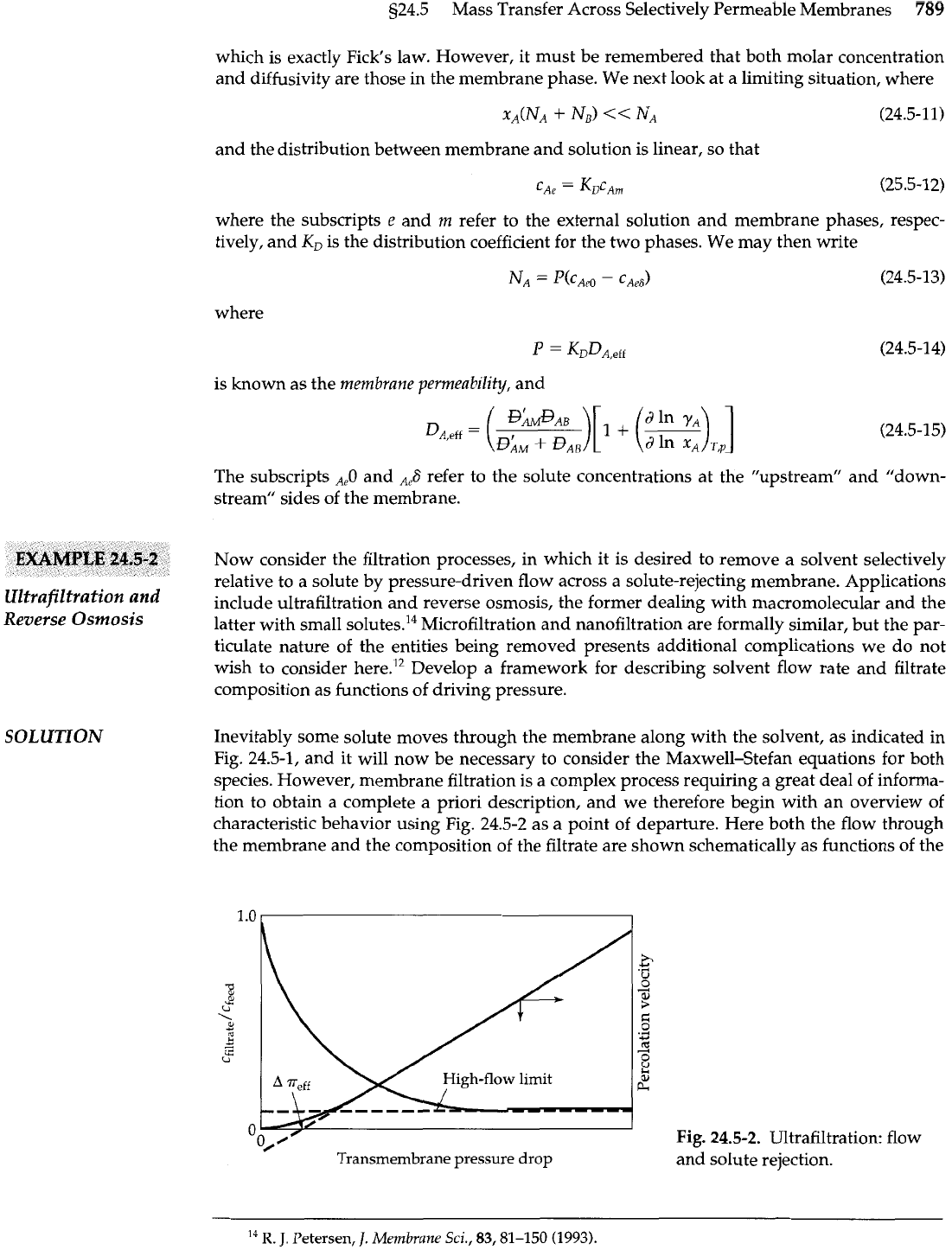
324.5 Mass Transfer Across Selectively Permeable Membranes
789
which is exactly Fick's law. However, it must be remembered that both molar concentration
and diffusivity are those in the membrane phase. We next look at a limiting situation, where
x*(NA
+
NB)
<<
N*
(24.5-1 1)
and the distribution between membrane and solution is linear, so that
=
K~c~m
(25.5-12)
where the subscripts
e
and
m
refer to the external solution and membrane phases, respec-
tively, and KD is the distribution coefficient for the two phases. We may then write
NA
=
P(c/.eO
-
cAe&
(24.5-13)
where
is known as the
membrane permeability,
and
D~,eff
=
(a;,
+
J1
+
The subscripts
AeO
and
refer to the solute concentrations at the "upstreamr' and "down-
stream" sides of the membrane.
EXAMPLE
24.5-2
Ultrafiltration
and
Now consider the filtration processes, in which it is desired to remove a solvent selectively
relative to a solute by pressure-driven flow across a solute-rejecting membrane. Applications
include ultrafiltration and reverse osmosis, the former dealing with macromolecular and the
Reverse
Osmosis
latter with small solutes.14 Microfiltration and nanofiltration are formally similar, but the par-
ticulate nature of the entities being removed presents additional complications we do not
wish to consider here.I2 Develop
a
framework for describing solvent flow rate and filtrate
composition as functions of driving pressure.
SOLUTION
Inevitably some solute moves through the membrane along with the solvent, as indicated in
Fig. 24.5-1, and it will now be necessary to consider the Maxwell-Stefan equations for both
species. However, membrane filtration is a complex process requiring a great deal of informa-
tion to obtain a complete a priori description, and we therefore begin with an overview of
characteristic behavior using Fig. 24.5-2 as a point of departure. Here both the flow through
the membrane and the composition of the filtrate are shown schematically as functions of the
Transmembrane pressure drop
Fig.
24.5-2.
Ultrafiltration: flow
and solute rejection.
-
--
l4
R.
J.
Petersen,
I.
Membrane
Sci.,
83,81-150
(1993).
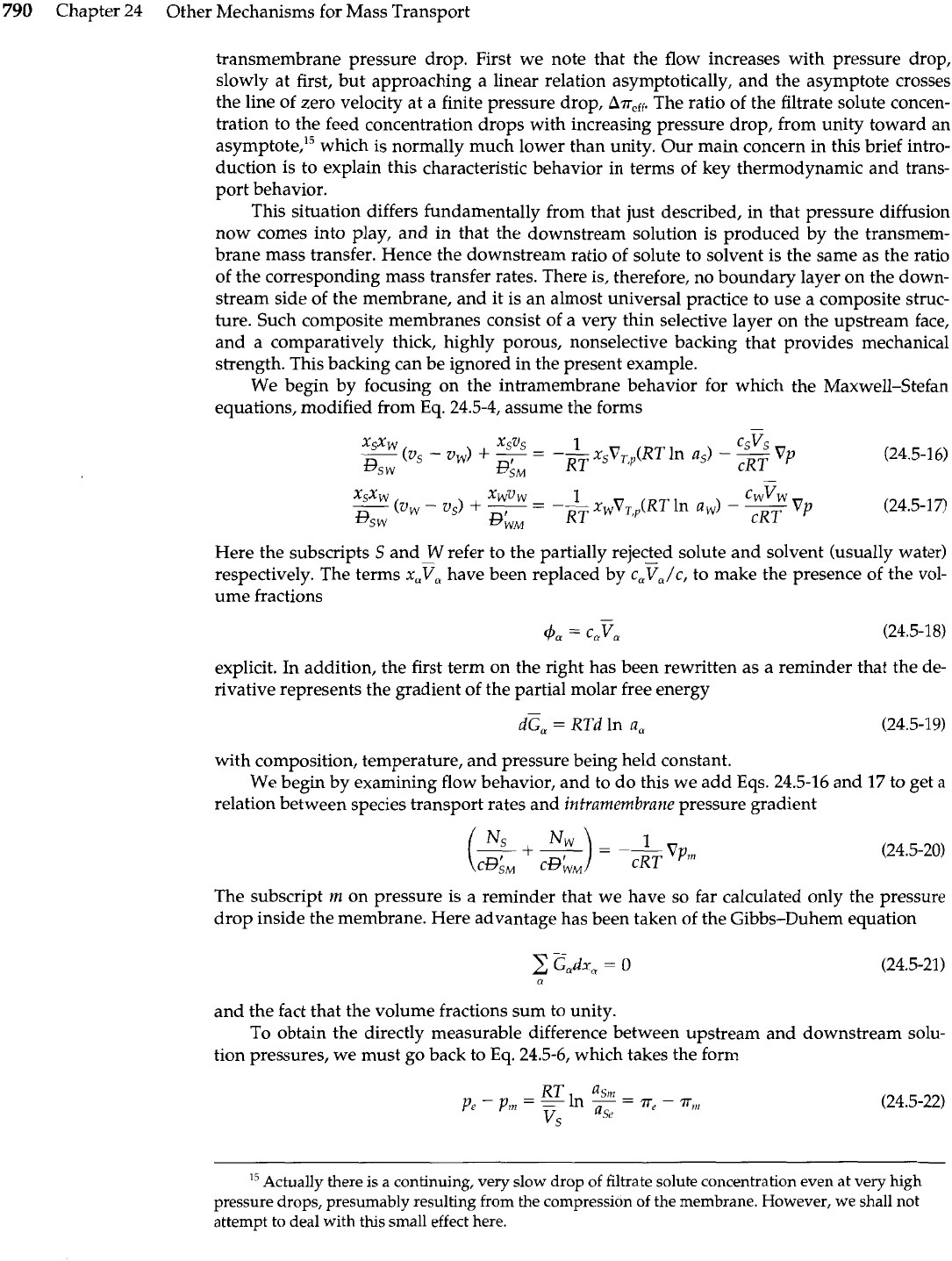
790
Chapter
24
Other Mechanisms for Mass Transport
transmembrane pressure drop. First we note that the flow increases with pressure drop,
slowly at first, but approaching a linear relation asymptotically, and the asymptote crosses
the line of zero velocity at a finite pressure drop, The ratio of the filtrate solute concen-
tration to the feed concentration drops with increasing pressure drop, from unity toward an
asymptote,15 which is normally much lower than unity. Our main concern in this brief intro-
duction is to explain this characteristic behavior in terms of key thermodynamic and trans-
port behavior.
This situation differs fundamentally from that just described, in that pressure diffusion
now comes into play, and in that the downstream solution is produced by the transmem-
brane mass transfer. Hence the downstream ratio of solute to solvent is the same as the ratio
of the corresponding mass transfer rates. There is, therefore, no boundary layer on the down-
stream side of the membrane, and it is an almost universal practice to use a composite struc-
ture. Such composite membranes consist of a very thin selective layer on the upstream face,
and a comparatively thick, highly porous, nonselective backing that provides mechanical
strength. This backing can be ignored in the present example.
We begin by focusing on the intramembrane behavior for which the Maxwell-Stefan
equations, modified from
Eq.
24.5-4, assume the forms
Here the subscripts
S
and
W
refer to the partially rejected solute and solvent (usually water)
respectively. The terms
x,~,
have been replaced by c,v,/c, to make the presence of the vol-
ume fractions
4,
=
cx
(24.5-18)
explicit. In addition, the first term on the right has been rewritten as a reminder that the de-
rivative represents the gradient of the partial molar free energy
with composition, temperature, and pressure being held constant.
We begin by examining flow behavior, and to do this we add Eqs. 24.5-16 and
17
to get
a
relation between species transport rates and
intramembrane
pressure gradient
The subscript
m
on pressure is a reminder that we have so far calculated only the pressure
drop inside the membrane. Here advantage has been taken of the Gibbs-Duhem equation
and the fact that the volume fractions sum to unity.
To obtain the directly measurable difference between upstream and downstream solu-
tion pressures, we must go back to
Eq.
24.5-6, which takes the form
'%ctually there is a continuing, very slow drop of filtrate solute concentration even at very high
pressure drops, presumably resulting from the compression of the membrane. However, we shall not
attempt
to
deal with this small effect here.
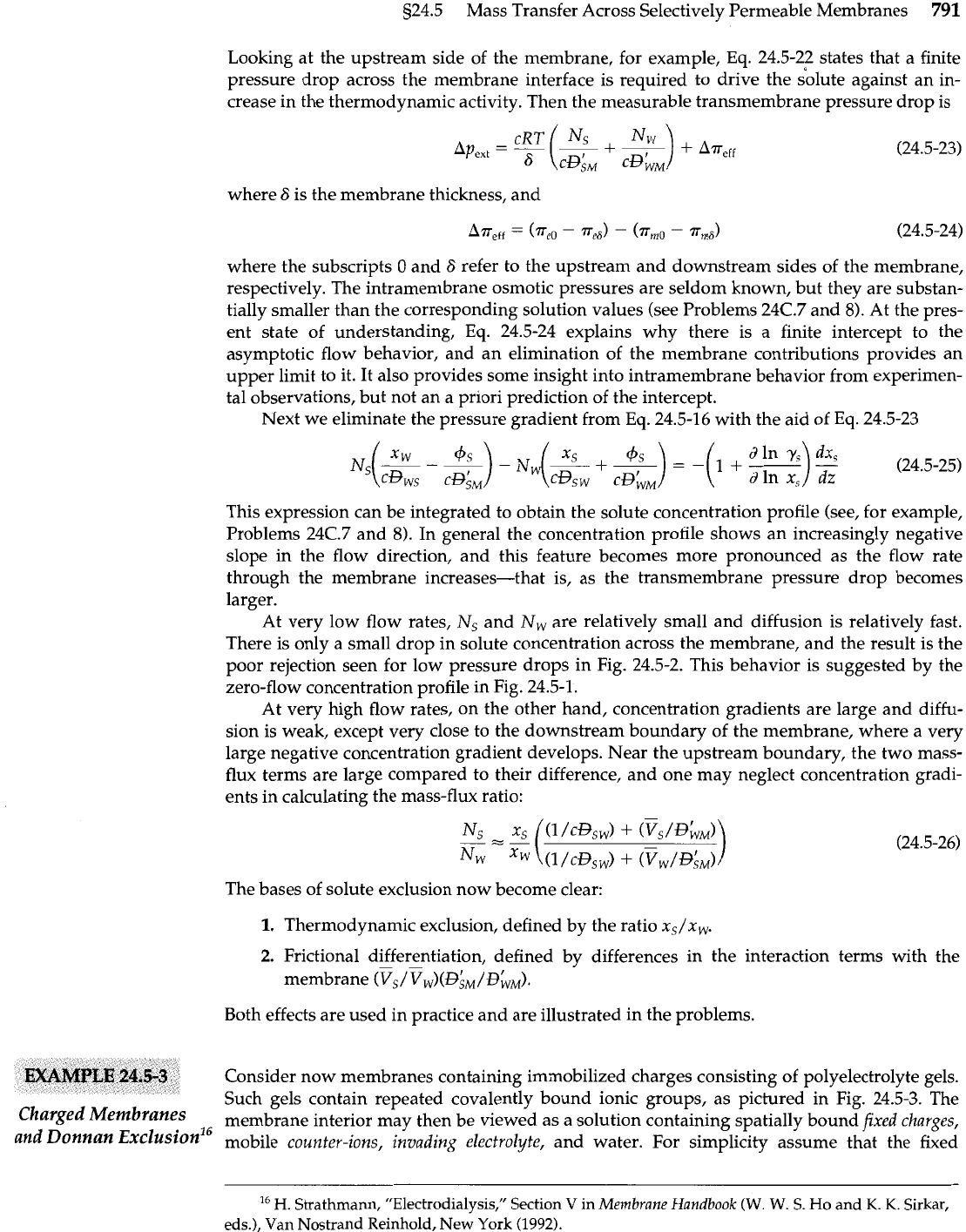
s24.5 Mass Transfer Across Selectively Permeable Membranes
791
Looking at the upstream side of the membrane, for example,
Eq.
24.5-22 states that a finite
pressure drop across the membrane interface is required to drive the solute against an in-
crease in the thermodynamic activity. Then the measurable transmembrane pressure drop is
where
6
is the membrane thickness, and
where the subscripts
0
and
6
refer to the upstream and downstream sides of the membrane,
respectively. The intramembrane osmotic pressures are seldom known, but they are substan-
tially smaller than the corresponding solution values (see Problems 24C.7 and
8).
At the pres-
ent state of understanding,
Eq.
24.5-24 explains why there is a finite intercept to the
asymptotic flow behavior, and an elimination of the membrane contributions provides an
upper limit to it. It also provides some insight into intramembrane behavior from experimen-
tal observations, but not an a priori prediction of the intercept.
Next we eliminate the pressure gradient from
Eq.
24.5-16 with the aid of
Eq.
24.5-23
This expression can be integrated to obtain the solute concentration profile (see, for example,
Problems 24C.7 and
8).
In general the concentration profile shows an increasingly negative
slope in the flow direction, and this feature becomes more pronounced as the flow rate
through the membrane increases-that is, as the transmembrane pressure drop becomes
larger.
At very low flow rates,
Ns
and
Nw
are relatively small and diffusion is relatively fast.
There is only a small drop in solute concentration across the membrane, and the result is the
poor rejection seen for low pressure drops in Fig. 24.5-2. This behavior is suggested by the
zero-flow concentration profile in Fig. 24.5-1.
At very high flow rates, on the other hand, concentration gradients are large and diffu-
sion is weak, except very close to the downstream boundary of the membrane, where a very
large negative concentration gradient develops. Near the upstream boundary, the two mass-
flux terms are large compared to their difference, and one may neglect concentration gradi-
ents in calculating the mass-flux ratio:
The bases of solute exclusion now become clear:
1.
Thermodynamic exclusion, defined by the ratio
xs/x,
2.
Frictional differentiation, defined by differences in the interaction terms with the
-
-
membrane
(Vs/Vw)(3kM/Bh,).
Both effects are used in practice and are illustrated in the problems.
Consider now membranes containing immobilized charges consisting of polyelectrolyte gels.
Such gels contain repeated covalently bound ionic groups, as pictured in Fig. 24.5-3. The
Charged Membranes
membrane interior may then be viewed as a solution containing spatially bound
fixed
charges,
and
lbm~~
~xclusion'~
mobile counter-ions, invading electrolyte, and water. For simplicity assume that the fixed
l6
H.
Strathmann, "Electrodialysis," Section
V
in
Membrane Handbook
(W.
W.
S. Ho and
K.
K.
Sirkar,
eds.), Van Nostrand Reinhold, New
York
(1992).
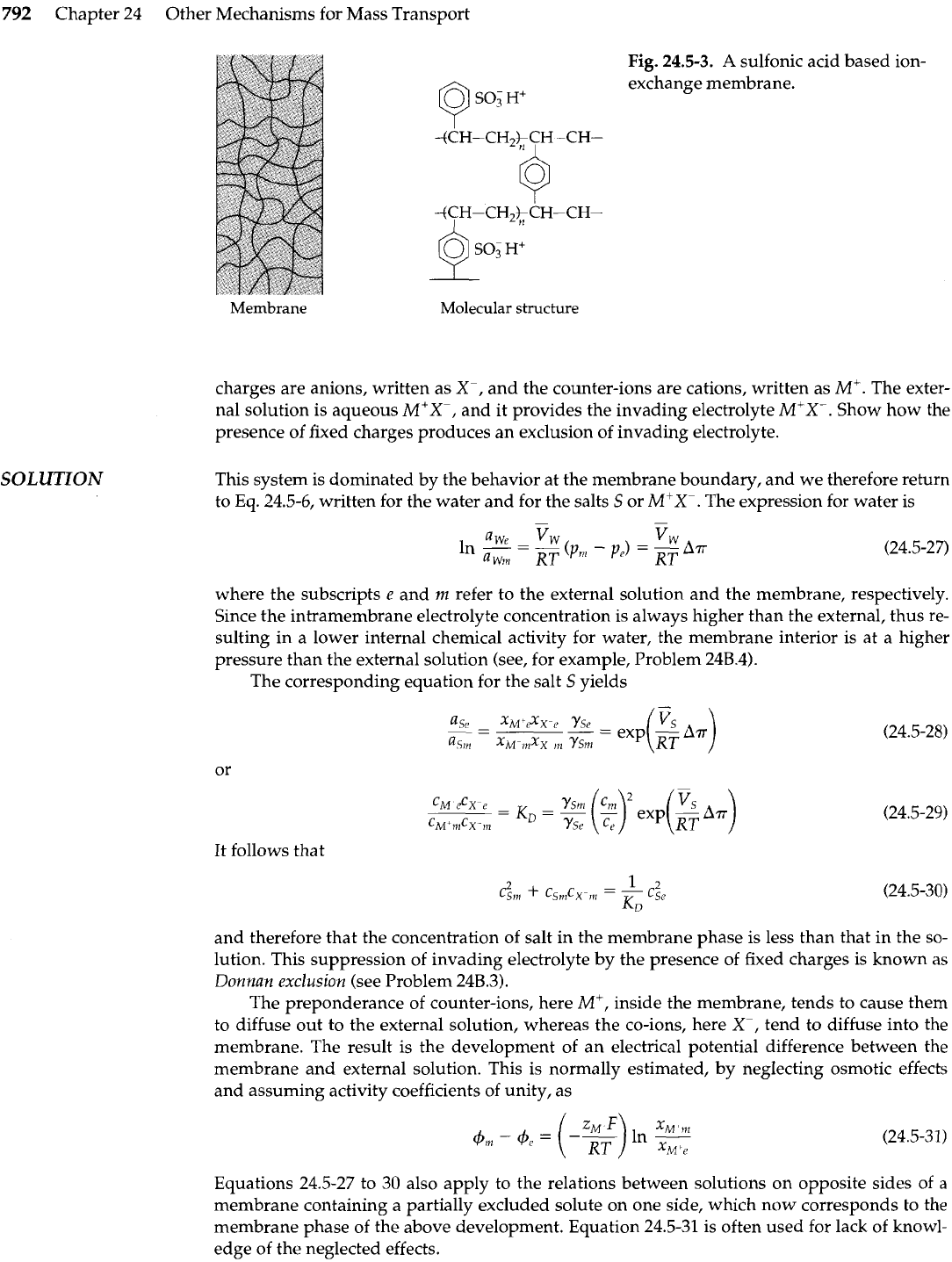
792
Chapter 24 Other Mechanisms for Mass Transport
SOLUTION
Fig.
24.5-3. A
sulfonic acid based ion-
exchange membrane.
Membrane
Molecular
structure
charges are anions, written as X-, and the counter-ions are cations, written as M'. The exter-
nal solution is aqueous M+X-, and it provides the invading electrolyte M'X-. Show how the
presence of fixed charges produces an exclusion of invading electrolyte.
This system is dominated by the behavior at the membrane boundary, and we therefore return
to Eq. 24.5-6, written for the water and for the salts
S
or MY. The expression for water is
where the subscripts
e
and
m
refer to the external solution and the membrane, respectively.
Since the intramembrane electrolyte concentration is always higher than the external, thus re-
sulting
in
a lower internal chemical activity for water, the membrane interior is at a higher
pressure than the external solution (see, for example, Problem 248.4).
The corresponding equation for the salt
S
yields
or
It follows that
-
X~'eX~-e
Y5e
--
-
=
exp(%
An)
X~-mX~
In
Y~wi
and therefore that the concentration of salt in the membrane phase is less than that in the so-
lution. This suppression of invading electrolyte by the presence of fixed charges is known as
Donnan exclusion
(see Problem 248.3).
The preponderance of counter-ions, here
M+,
inside the membrane, tends to cause them
to diffuse out to the external solution, whereas the co-ions, here X-, tend to diffuse into the
membrane. The result is the development of an electrical potential difference between the
membrane and external solution. This is normaIly estimated, by negIecting osmotic effects
and assuming activity coefficients of unity, as
Equations 24.5-27 to
30
also apply to the relations between solutions on opposite sides of
a
membrane containing a partiaIly excluded solute on one side, which now corresponds to the
membrane phase of the above development. Equation 24.5-31 is often used for lack of knowl-
edge
of
the neglected effects.
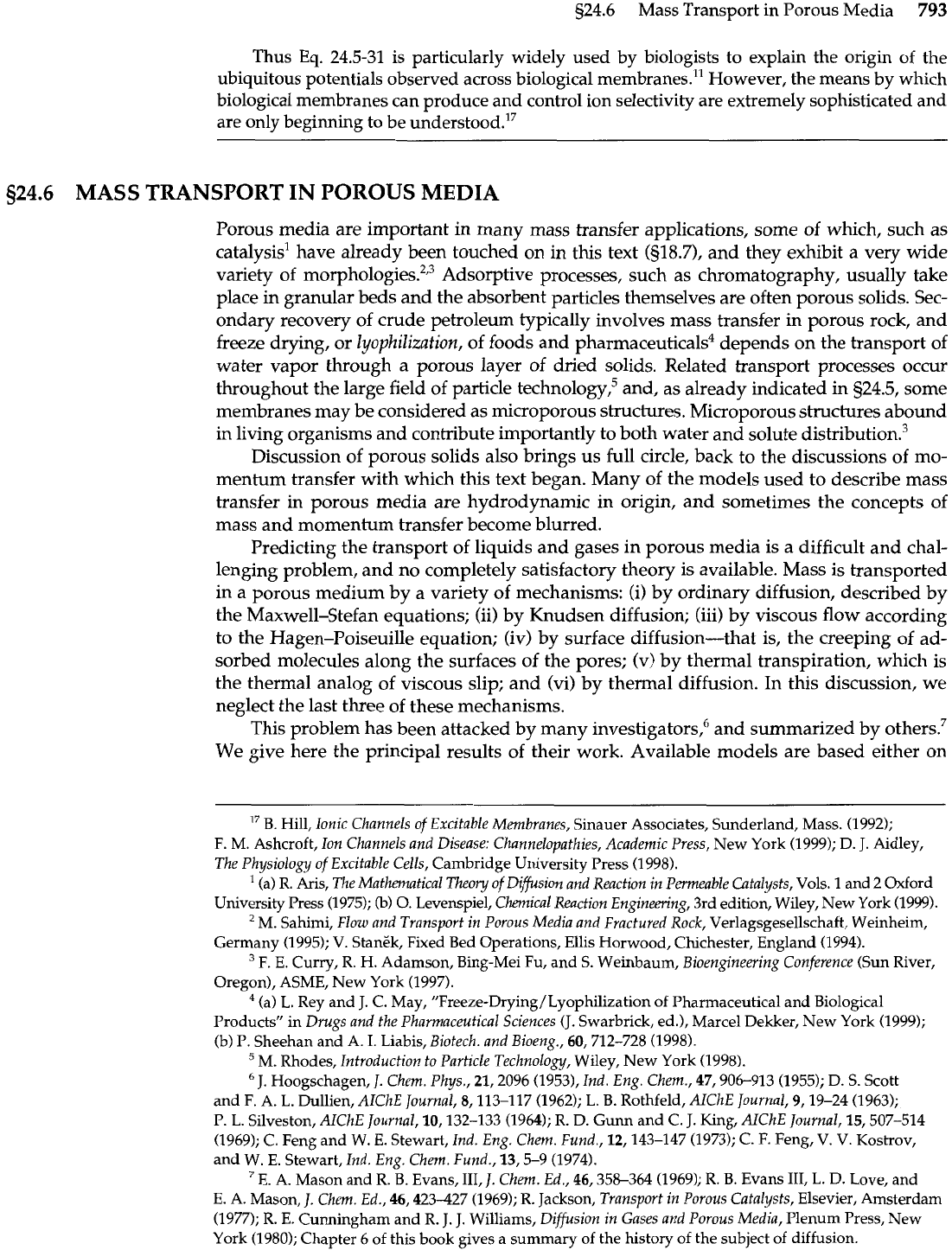
524.6 Mass Transport in Porous Media
793
Thus Eq. 24.5-31 is particularly widely used
by
biologists to explain the origin of the
ubiquitous potentials observed across biological membranes.'' However, the means by which
biological membranes can produce and control ion selectivity are extremely sophisticated and
are only beginning to be understood.17
524.6
MASS TRANSPORT
IN
POROUS
MEDIA
Porous media are important in many mass transfer applications, some of which, such as
catalysis1 have already been touched on in this text
(§18.7),
and they exhibit a very wide
variety of morph~logies.~,~ Adsorptive processes, such as chromatography, usually take
place in granular beds and the absorbent particles themselves are often porous solids. Sec-
ondary recovery of crude petroleum typically involves mass transfer in porous rock, and
freeze drying, or lyophilization, of foods and pharmaceuticals4 depends on the transport of
water vapor through a porous layer of dried solids. Related transport processes occur
throughout the large field of particle technology,5 and, as already indicated in
S24.5,
some
membranes may be considered as microporous structures. Microporous structures abound
in living organisms and contribute importantly to both water and solute distribution3
Discussion of porous solids also brings us full circle, back to the discussions of mo-
mentum transfer with which this text began. Many of the models used to describe mass
transfer in porous media are hydrodynamic in origin, and sometimes the concepts of
mass and momentum transfer become blurred.
Predicting the transport of liquids and gases in porous media is a difficult and chal-
lenging problem, and no completely satisfactory theory is available. Mass is transported
in a porous medium by a variety of mechanisms: (i) by ordinary diffusion, described by
the MaxwellStefan equations; (ii) by Knudsen diffusion; (iii) by viscous flow according
to the Hagen-Poiseuille equation;
(iv)
by surface diffusion-that is, the creeping of ad-
sorbed molecules along the surfaces of the pores; (v) by thermal transpiration, which is
the thermal analog of viscous slip; and (vi) by thermal diffusion. In this discussion, we
neglect the last three of these mechanisms.
This problem has been attacked by many investigators: and summarized by othem7
We give here the principal results of their work. Available models are based either on
l7
B. Hill,
Ionic Channels of Excitable Membranes,
Sinauer Associates, Sunderland, Mass. (1992);
F.
M. Ashcroft,
Ion Channels and Disease: Channelopathies, Academic Press,
New York (1999); D.
J.
Aidley,
The Physiology of Excitable Cells,
Cambridge University Press (1998).
(a) R. Aris,
The Mathematical Tkeoy of Diffusion and Reaction in Permeable Catalysts,
Vols.
1
and
2
Oxford
University Press (1975);
(b)
0. Levenspiel,
Chemical Reaction Engineering,
3rd edition, Wiley, New York (1999).
M.
Sahimi,
Flow and Transport in Porous Media and Fractured Rock,
Verlagsgesellschaft, Weinheim,
Germany (1995); V. StanPk, Fixed Bed Operations, Ellis Horwood, Chichester, England (1994).
F.
E.
Curry, R.
H.
Adamson, Bing-Mei Fu, and S. Weinbaum,
Bioengineering Conference
(Sun River,
Oregon), ASME, New York (1997).
(a) L. Rey and
J.
C. May,
"Freeze-Drying/Lyophilization
of Pharmaceutical and Biological
Products" in
Drugs and the Pharmaceutical Sciences
(J.
Swarbrick, ed.), Marcel Dekker, New York (1999);
(b)
P.
Sheehan and
A.
I.
Liabis,
Biotech. and Bioeng.,
60,712-728 (1998).
M. Rhodes,
Introduction to Particle Technology,
Wiley, New York (1998).
J.
Hoogschagen,
J.
Chem. Phys.,
21,2096 (1953),
Ind. Eng. Chem.,
47,906-913 (1955);
D.
S. Scott
and
F.
A. L. Dullien,
AIChE Journal,
8,113-117 (1962);
L.
B. Rothfeld,
AIChE Journal,
9,19-24 (1963);
P.
L.
Silveston,
AIChE Journal,
10,132-133 (1964); R. D. Gunn and C.
J.
King,
AIChE Journal,
15,507-514
(1969); C. Feng and W.
E.
Stewart,
Ind. Eng. Chem. Fund.,
12,143-147 (1973); C.
F.
Feng, V. V. Kostrov,
and
W.
E. Stewart,
Ind. Eng. Chem. Fund.,
13,5-9 (1974).
E. A. Mason and R. B. Evans,
II1,J. Chem. Ed.,
46,358-364 (1969);
R.
B. Evans
111,
L.
D. Love, and
E.
A. Mason,
J.
Chem. Ed.,
46,423427 (1969); R. Jackson,
Transport in Porous Catalysts,
Elsevier, Amsterdam
(1977); R. E. Cunningham and R.
J. J.
Williams,
Diffusion in Gases and Porous Media,
Plenum Press, New
York (1980); Chapter 6 of this book gives a summary of the history of the subject of diffusion.
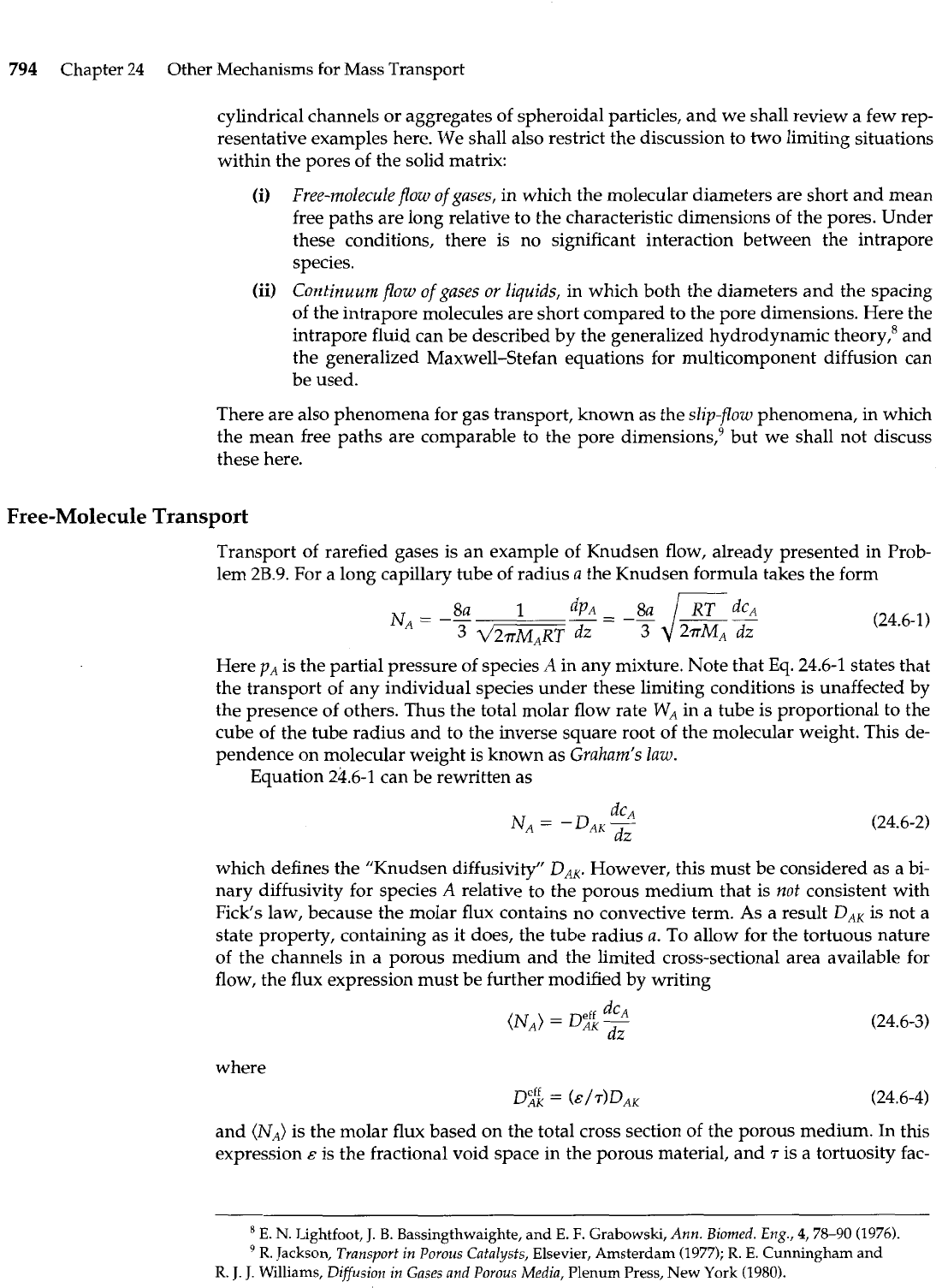
794
Chapter 24 Other Mechanisms for Mass Transport
cylindrical channels or aggregates of spheroidal particles, and we shall review a few rep-
resentative examples here. We shall also restrict the discussion to two limiting situations
within the pores of the solid matrix:
(i)
Free-molecule flow of
gases,
in which the molecular diameters are short and mean
free paths are long relative to the characteristic dimensions of the pores. Under
these conditions, there is no significant interaction between the intrapore
species.
(ii)
Continuum flow of
gases
or
liquids, in which both the diameters and the spacing
of the intrapore molecules are short compared to the pore dimensions. Here the
intrapore fluid can be described by the generalized hydrodynamic theory,%nd
the generalized Maxwell-Stefan equations for multicomponent diffusion can
be used.
There are also phenomena for gas transport, known as the
slip-flow
phenomena, in which
the mean free paths are comparable to the pore dimensions: but we shall not discuss
these here.
Free-Molecule Transport
Transport of rarefied gases is an example of Knudsen flow, already presented in Prob-
lem 2B.9. For a long capillary tube of radius
a
the Knudsen formula takes the form
Here
pA
is the partial pressure of species
A
in any mixture. Note that
Eq.
24.6-1 states that
the transport of any individual species under these limiting conditions is unaffected by
the presence of others. Thus the total molar flow rate
WA
in
a
tube is proportional to the
cube of the tube radius and to the inverse square root of the molecular weight. This de-
pendence on molecular weight is known as
Graham's law.
Equation 24.6-1 can be rewritten as
which defines the "Knudsen diffusivity"
DAK.
However, this must be considered as a bi-
nary diffusivity for species
A
relative to the porous medium that is
not
consistent with
Fick's law, because the molar flux contains no convective term. As a result
DAK
is not a
state property, containing as it does, the tube radius
a.
To allow for the tortuous nature
of the channels in a porous medium and the limited cross-sectional area available for
flow, the flux expression must be further modified by writing
where
Ds
=
(&/7)DAK
and
(NA)
is the molar flux based on the total cross section of the porous medium. In this
expression
8
is the fractional void space in the porous material, and
r
is a tortuosity fac-
E.
N.
Lightfoot,
J.
B. Bassingthwaighte, and
E.
F.
Grabowski,
Ann.
Biomed. Eng.,
4,78-90 (1976).
R.
Jackson,
Transport in Porous
Catalysts,
Elsevier, Amsterdam (1977);
R.
E.
Cunningham and
R.
J.
J.
Williams,
Diffxsion in Gases and Porous Media,
Plenum Press, New
York
(1980).
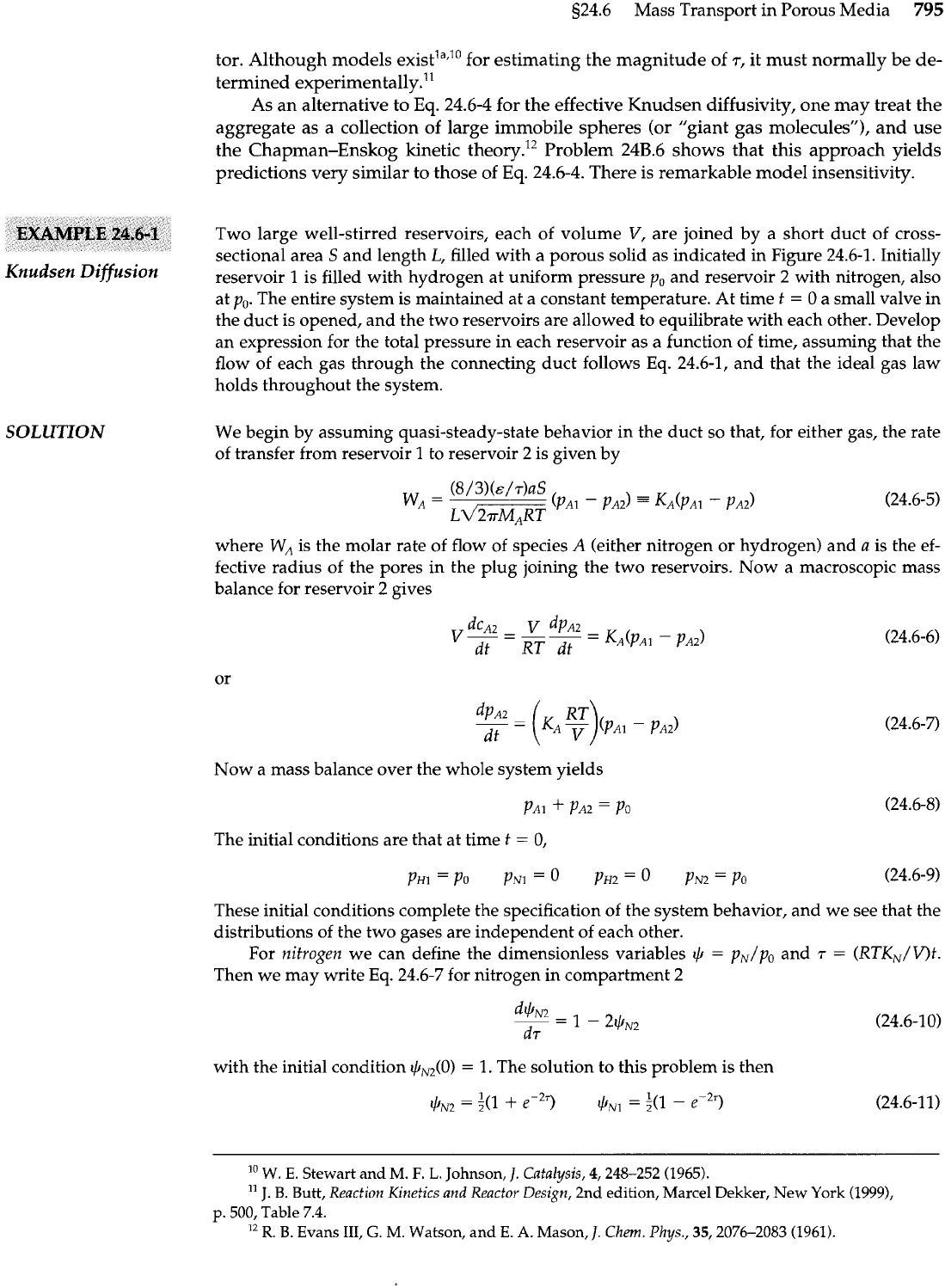
s24.6 Mass Transport in Porous Media
795
tor. Although models existla,'"for estimating the magnitude of
T,
it must normally be de-
termined experimentally."
As an alternative to
Eq.
24.6-4 for the effective Knudsen diffusivity, one may treat the
aggregate as a collection of large immobile spheres (or "giant gas molecules"), and use
the Chapman-Enskog kinetic theory.'' Problem 24B.6 shows that this approach yields
predictions very similar to those of
Eq.
24.6-4. There is remarkable model insensitivity.
EXAMPLE
24.6-1
Knudsen
Diffusion
Two large well-stirred reservoirs, each of volume
V,
are joined by a short duct of cross-
sectional area
S
and length
L,
filled with a porous solid as indicated in Figure 24.6-1. Initially
reservoir
1
is filled with hydrogen at uniform pressure
p,
and reservoir
2
with nitrogen, also
at p,. The entire system is maintained at a constant temperature. At time
t
=
0
a small valve in
the duct is opened, and the two reservoirs are allowed to equilibrate with each other. Develop
an expression for the total pressure in each reservoir as a function of time, assuming that the
flow of each gas through the connecting duct follows Eq. 24.6-1, and that the ideal gas law
holds throughout the system.
SOLUTION
We begin by assuming quasi-steady-state behavior in the duct so that, for either gas, the rate
of transfer from reservoir 1 to reservoir 2 is given
by
where
W,,
is the molar rate of flow of species
A
(either nitrogen or hydrogen) and
a
is the ef-
fective radius of the pores in the plug joining the two reservoirs. Now a macroscopic mass
balance for reservoir 2 gives
Now
a
mass balance over the whole system yields
The initial conditions are that at time
t
=
0,
These initial conditions complete the specification of the system behavior, and we see that the
distributions of the two gases are independent of each other.
For
nitrogen
we can define the dimensionless variables
t,b
=
pN/po and
7
=
(RTKN/V)t.
Then we may write Eq. 24.6-7 for nitrogen in compartment 2
with the initial condition $hN2(0)
=
1.
The solution to this problem is then
lo
W.
E.
Stewart and
M.
F.
L.
Johnson,
7.
Catalysis,
4,248-252
(1965).
"
J.
B.
Butt,
Reaction Kinetics and Reactor Design,
2nd edition, Marcel Dekker, New York (19991,
p.
500, Table
7.4.
l2
R.
B.
Evans
111,
G.
M.
Watson, and E.
A.
Mason,
1.
Chem.
Phys.,
35,2076-2083
(1961).
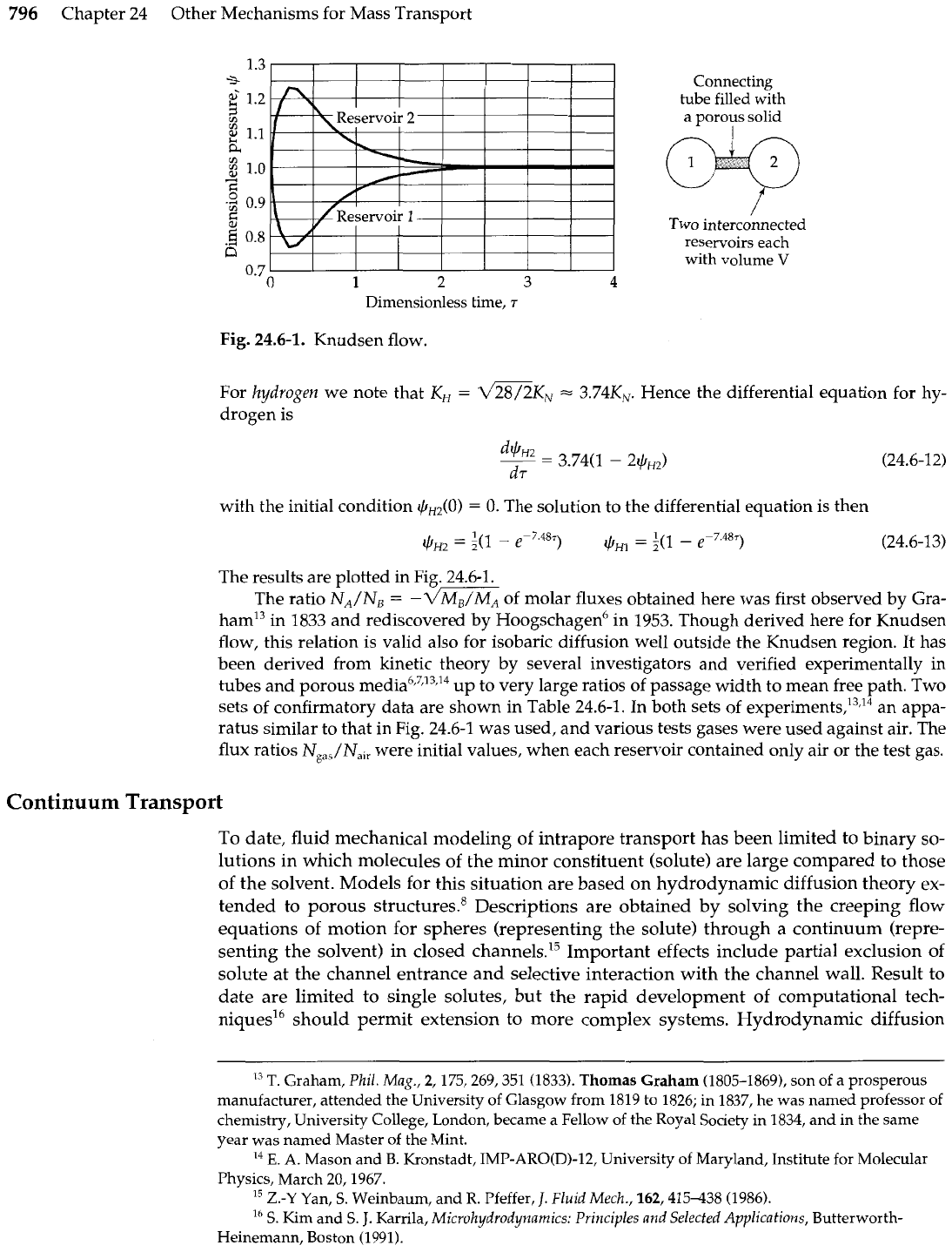
796
Chapter 24 Other Mechanisms for Mass Transport
Connecting
tube filled with
a porous solid
w
Two interconnected
reservoirs each
with volume
V
0
1
2 3
4
Dimensionless time,
T
Fig.
24.6-1.
Knudsen flow.
For
hydrogen
we note that
KH
=
a~~
=
3.74K,.
Hence the differential equation for hy-
drogen is
with the initial condition
$,,(O)
=
0.
The solution to the differentia1 equation is then
The results are plotted in Fig. 24.6-1.
The ratio
NA/NB
=
--
of molar fluxes obtained here was first observed
by
Gra-
ham13 in 1833 and rediscovered by ~oo~scha~en' in
1953.
Though derived here for Knudsen
flow, this relation is valid also for isobaric diffusion well outside the Knudsen region.
It
has
been derived from kinetic theory by several investigators and verified experimentally in
tubes and porous media6,7,'3,14 up to very large ratios of passage width to mean free path. Two
sets of confirmatory data are shown in Table 24.6-1. In both sets of e~~eriments,'~.'~ an appa-
ratus similar to that in Fig. 24.6-1 was used, and various tests gases were used against air. The
flux ratios
N,,,/N,,,
were initial values, when each reservoir contained only air or the test gas.
Continuum Transport
To date, fluid mechanical modeling of intrapore transport has been limited to binary so-
lutions in which molecules of the minor constituent (solute) are large compared to those
of the solvent. Models for this situation are based on hydrodynamic diffusion theory ex-
tended to porous
structure^.^
Descriptions are obtained by solving the creeping flow
equations of motion for spheres (representing the solute) through a continuum (repre-
senting the solvent) in closed channels.15 Important effects include partial exclusion of
solute at the channel entrance and selective interaction with the channel wall. Result to
date are limited to single solutes, but the rapid development of computational tech-
nique~'~ should permit extension to more complex systems. Hydrodynamic diffusion
'q.
Graham,
Phil. Mag.,
2,175,269,351 (1833).
Thomas
Graham
(1805-1869), son of a prosperous
manufacturer, attended the University of Clasgow from 1819 to 1826; in 1837, he was named professor of
chemistry, University College, London, became a Fellow of the Royal Society in 1834, and in the same
year was named Master of the Mint.
l4
E.
A. Mason and B. Kronstadt, IMP-ARO(D)-12, University of Maryland, Institute for Molecular
Physics, March 20,1967.
l5
Z.-Y
Yan,
S.
Weinbaum, and
R.
Pfeffer,
J.
Fluid Mech.,
162,415438 (1986).
''
S. Kim and
S.
J.
Karrila,
Microhydvodynamics: Principles and Selected Applications,
Butterworth-
Heinemann, Boston (1991).
